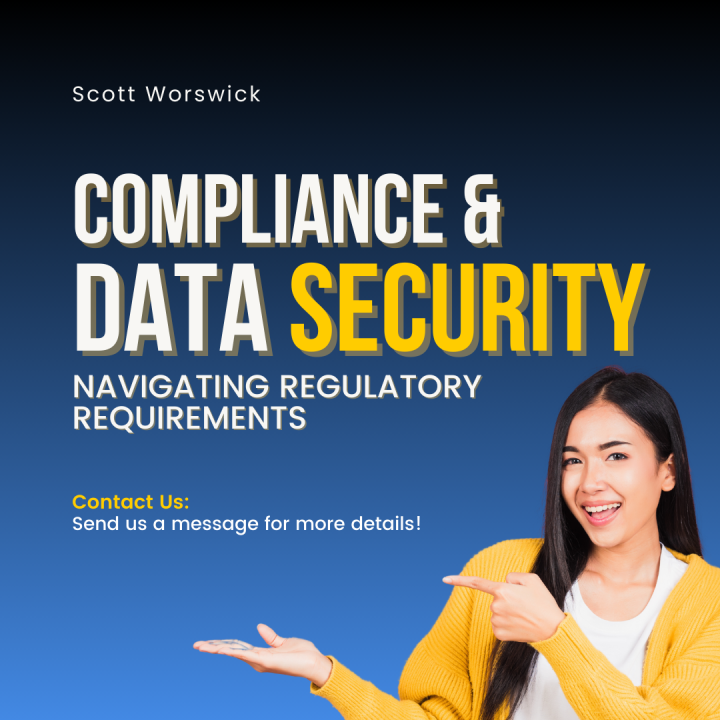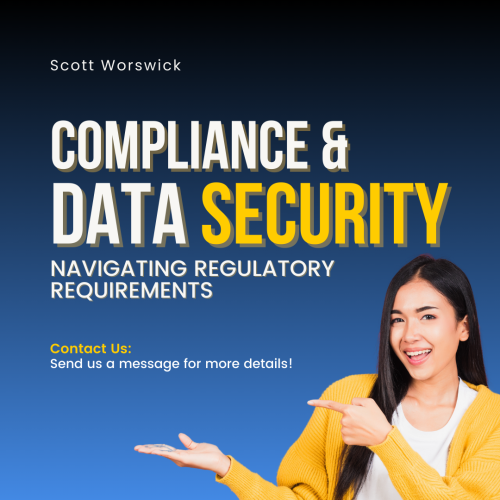
Compliance and Data Security:
Navigating Regulatory Requirements
In the digital age, where data has become one of the most valuable assets for businesses, ensuring its security and compliance with regulatory standards has never been more critical. As organizations harness the power of technology to drive innovation and growth, they must also navigate a complex web of regulatory requirements aimed at protecting sensitive information. From GDPR in Europe to HIPAA in the healthcare sector and CCPA in California, these regulations set the bar for data protection and privacy, requiring businesses to implement robust measures to safeguard against breaches and unauthorized access.
To effectively navigate the regulatory landscape, businesses must first grasp the intricacies of the various regulations governing data security within their industry and geographical region. These regulations not only mandate specific measures for protecting sensitive data but also impose severe penalties for non-compliance. By understanding the regulatory requirements pertinent to their operations, organizations can proactively implement policies and procedures that not only ensure compliance but also enhance their overall security posture, safeguarding against potential threats and vulnerabilities.
Compliance with regulatory requirements is not merely a legal obligation but also a strategic imperative for businesses looking to build trust with customers and stakeholders. A single data breach can have far-reaching consequences, damaging reputation, eroding customer trust, and incurring significant financial losses. Therefore, organizations must prioritize data security as a fundamental aspect of their operations, embedding it into their corporate culture and business processes. By adopting a proactive approach to compliance and data security, businesses can mitigate risks, protect sensitive information, and demonstrate their commitment to safeguarding the privacy and integrity of data entrusted to them.
1. Understanding Regulatory Landscape
Navigating the regulatory landscape is akin to deciphering a complex puzzle, with each piece representing a different aspect of data security and compliance. From GDPR in Europe to HIPAA in healthcare and CCPA in California, various regulations shape the framework within which businesses must operate to protect sensitive information. These regulations not only outline specific requirements for data protection but also establish guidelines for handling and storing data securely. Understanding the nuances of these regulations is paramount for businesses seeking to maintain compliance and uphold the trust of their customers.
Each regulatory framework brings its own set of challenges and requirements, making it essential for businesses to carefully navigate the maze of regulations relevant to their industry and geographic location. For example, GDPR mandates stringent measures for protecting personal data, requiring businesses to obtain explicit consent from individuals and implement robust security measures to prevent unauthorized access. Similarly, HIPAA sets forth strict guidelines for safeguarding protected health information (PHI) in the healthcare sector, emphasizing the importance of confidentiality, integrity, and availability.
The consequences of failing to comply with regulatory requirements can be severe, ranging from hefty fines to reputational damage and legal liabilities. Data breaches resulting from non-compliance can expose organizations to significant financial losses and erode customer trust, leading to long-term consequences for their bottom line. Moreover, regulatory bodies have become increasingly vigilant in enforcing compliance, conducting audits and investigations to ensure that businesses adhere to data security standards. Therefore, it is imperative for organizations to prioritize compliance efforts and invest in robust data security measures to mitigate the risk of non-compliance.
Taking a proactive approach to compliance involves more than just ticking boxes; it requires a comprehensive understanding of regulatory requirements and a commitment to implementing best practices for data security. By staying abreast of regulatory updates, conducting regular risk assessments, and investing in employee training, organizations can strengthen their compliance efforts and reduce the likelihood of security incidents. Moreover, adopting a proactive stance towards compliance not only helps businesses avoid potential penalties but also enhances their reputation as trustworthy custodians of sensitive data.
.png)
2. Implementing Robust Policies and Procedures
In the realm of data security and regulatory compliance, the implementation of robust policies and procedures serves as the cornerstone of a strong defense against potential breaches and vulnerabilities. These policies must encompass a wide range of measures aimed at safeguarding sensitive information and ensuring adherence to regulatory standards. From data encryption and access controls to incident response plans and employee training, each component plays a crucial role in fortifying the organization's data security posture.
One of the fundamental aspects of data security is encryption, which involves encoding data to render it unreadable to unauthorized users. Implementing robust encryption protocols helps protect data both at rest and in transit, reducing the risk of unauthorized access and data breaches. In addition to encryption, access controls play a vital role in limiting the exposure of sensitive information by granting access only to authorized individuals based on their roles and permissions within the organization.
Despite best efforts to prevent data breaches, incidents may still occur, making it imperative for organizations to have robust incident response plans in place. These plans outline the steps to be taken in the event of a security incident, including containment, investigation, and notification procedures. Equally important is ongoing employee training, which ensures that staff members are equipped with the knowledge and skills necessary to identify and respond to security threats effectively. By fosterin
g a culture of security awareness, organizations empower employees to become active participants in safeguarding sensitive data.
In today's interconnected business ecosystem, many organizations rely on third-party vendors and service providers to support their operations. However, outsourcing certain functions also introduces additional risks to data security, as third-party vendors may have access to sensitive information. Implementing robust vendor management protocols is essential for mitigating these risks and ensuring that vendors adhere to the same rigorous data security standards as the organization itself. This includes conducting thorough due diligence assessments, establishing clear contractual agreements, and regularly monitoring vendor performance to ensure compliance with regulatory requirements.
3. Leveraging Technology Solutions for Data Security
In the ever-evolving landscape of data security and regulatory compliance, leveraging technology solutions is paramount to fortify defenses against cyber threats and ensure adherence to regulatory standards. Advanced cybersecurity tools and platforms offer a wide array of features designed to enhance data protection, from threat detection and prevention to encryption and secure storage. By harnessing the power of technology, organizations can bolster their data security posture and navigate regulatory requirements with confidence.
The arsenal of advanced cybersecurity tools available today provides organizations with a comprehensive suite of capabilities to safeguard sensitive information. From firewalls and intrusion detection systems to endpoint protection software and security information and event management (SIEM) solutions, these tools enable organizations to detect and respond to security threats in real-time. By implementing a layered approach to data security that incorporates multiple technologies, organizations can create a formidable defense against cyberattacks and unauthorized access.
Cloud computing has revolutionized the way organizations store, manage, and access data, offering scalability, flexibility, and cost-effectiveness. Cloud-based platforms provide built-in security features such as encryption, data masking, and access controls, allowing organizations to securely store and process sensitive information while adhering to regulatory mandates. Moreover, cloud providers often maintain robust compliance certifications and undergo regular audits to ensure adherence to industry standards, further enhancing data security and regulatory compliance.
In addition to standalone cybersecurity tools, organizations can benefit from integrated security solutions that offer a holistic approach to data security and regulatory compliance. These solutions combine various functionalities, such as data loss prevention (DLP), identity and access management (IAM), and security orchestration, automation, and response (SOAR), into a unified platform. By streamlining security operations and centralizing management, integrated solutions enable organizations to achieve greater efficiency and effectiveness in managing data security risks while meeting regulatory requirements.

4. Adopting a Risk-Based Approach
In the dynamic landscape of data security and regulatory compliance, adopting a risk-based approach is essential for organizations to effectively allocate resources and prioritize efforts. Rather than taking a one-size-fits-all approach to compliance, organizations must assess their unique risk landscape and tailor their strategies accordingly. By identifying and evaluating potential risks to data security, organizations can focus their efforts on mitigating the most significant threats while optimizing resource allocation and maximizing the effectiveness of their compliance initiatives.
Central to a risk-based approach is the conduct of comprehensive risk assessments, which enable organizations to identify, analyze, and prioritize potential risks to data security. These assessments involve evaluating various factors, including the sensitivity of the data being handled, the likelihood and impact of potential security incidents, and the effectiveness of existing controls and safeguards. By gaining a deeper understanding of their risk landscape, organizations can make informed decisions about where to allocate resources and implement measures to mitigate identified risks effectively.
By adopting a risk-based approach to compliance, organizations can optimize their efforts and resources to focus on areas of highest risk and greatest impact. Rather than spreading resources thinly across all aspects of compliance, organizations can concentrate on implementing measures that address the most significant threats to data security. This targeted approach not only enhances the organization's ability to protect sensitive information but also enables it to demonstrate a proactive stance towards compliance, building trust with customers, regulators, and other stakeholders in the process.
5. Fostering a Culture of Compliance
Creating a culture of compliance within an organization is fundamental to upholding data security standards and navigating regulatory requirements effectively. It involves instilling a mindset of accountability, responsibility, and awareness among employees at all levels, emphasizing the importance of safeguarding sensitive information and adhering to regulatory mandates. By fostering a culture of compliance, organizations can empower employees to become proactive participants in ensuring data security, thereby mitigating the risk of breaches and enhancing the organization's overall resilience.
Central to fostering a culture of compliance is promoting awareness and providing comprehensive training to employees on data security best practices and regulatory requirements. Through regular training sessions, workshops, and communication channels, employees can gain a deeper understanding of their roles and responsibilities in safeguarding sensitive information. By equipping employees with the knowledge and skills necessary to identify potential security threats and respond effectively, organizations can strengthen their defense against cyber risks and enhance their compliance efforts.
Effective leadership plays a pivotal role in fostering a culture of compliance within an organization. Leaders must lead by example, demonstrating a commitment to data security and regulatory compliance in their actions and decisions. By prioritizing data security initiatives, allocating resources, and promoting open communication channels, leaders can set the tone for the organization and inspire employees to embrace compliance as a core value. When employees see that data security is a top priority for leadership, they are more likely to adopt similar attitudes and behaviors, reinforcing a culture of compliance throughout the organization.
6. Ensuring Continuous Monitoring and Improvement
In the ever-evolving landscape of data security and regulatory compliance, ensuring continuous monitoring and improvement is paramount to staying ahead of emerging threats and evolving regulatory requirements. Organizations must adopt a proactive stance towards data security, implementing robust monitoring mechanisms to detect and respond to potential vulnerabilities and compliance gaps in real-time. By embracing a culture of continuous improvement, organizations can strengthen their resilience to cyber threats and enhance their overall compliance posture.
Continuous monitoring involves the ongoing surveillance of systems, networks, and data to detect and respond to security incidents as they occur. Advanced threat detection technologies, such as intrusion detection systems (IDS), security information and event management (SIEM) solutions, and endpoint detection and response (EDR) platforms, enable organizations to identify anomalous behavior and potential security breaches in real-time. By leveraging these technologies, organizations can proactively mitigate risks and prevent unauthorized access to sensitive data, thereby safeguarding against potential compliance violations.
In addition to real-time threat detection, organizations must conduct regular assessments and evaluations of their data security measures and compliance practices. This involves reviewing and analyzing security controls, policies, and procedures to identify areas for improvement and ensure alignment with regulatory requirements. By conducting periodic audits, risk assessments, and compliance reviews, organizations can identify potential vulnerabilities and address them proactively, minimizing the risk of non-compliance and data breaches.
Continuous monitoring and improvement should be an integral part of the organization's data security and compliance strategy, with dedicated initiatives aimed at enhancing security measures and processes over time. This may include implementing new technologies, updating policies and procedures, providing additional training to employees, and conducting regular exercises and simulations to test incident response capabilities. By embracing a mindset of continuous improvement, organizations can adapt to the evolving threat landscape and regulatory environment, ensuring that their data security practices remain robust and effective in mitigating risks and maintaining compliance.
Conclusion
In conclusion, navigating regulatory requirements and ensuring compliance with data security standards is a multifaceted endeavor that requires proactive strategies, robust policies, and a culture of vigilance within organizations. By understanding the regulatory landscape, implementing comprehensive data security measures, and fostering a culture of compliance, businesses can mitigate the risk of breaches and safeguard sensitive information effectively. However, compliance is not a one-time effort but an ongoing process that requires continuous monitoring, evaluation, and improvement to adapt to evolving threats and regulatory changes.
As the digital landscape continues to evolve and cyber threats become increasingly sophisticated, organizations must remain vigilant and adaptable in their approach to data security and compliance. Continuous monitoring, regular assessments, and proactive measures are essential to staying ahead of potential risks and maintaining compliance with regulatory requirements. By embracing a mindset of continuous improvement, organizations can enhance their resilience to cyber threats and ensure that their data security practices remain effective in safeguarding sensitive information.
Ultimately, compliance with regulatory requirements and robust data security practices are not only imperative for protecting sensitive information but also for building trust with customers, stakeholders, and regulatory bodies. By demonstrating a commitment to data security and compliance, organizations can enhance their reputation, mitigate the risk of reputational damage, and foster stronger relationships with stakeholders. Moreover, by investing in data security measures and fostering a culture of compliance, organizations can build resilience to cyber threats and position themselves for long-term success in an increasingly interconnected and data-driven world.
Thanks for visiting.

.png)
.png)